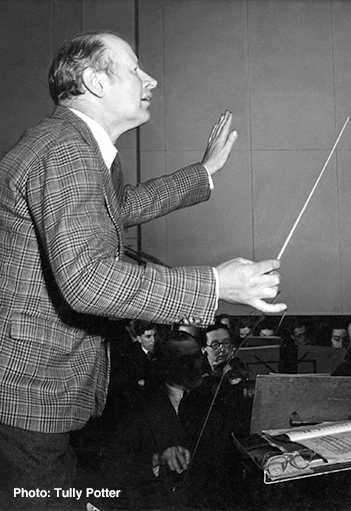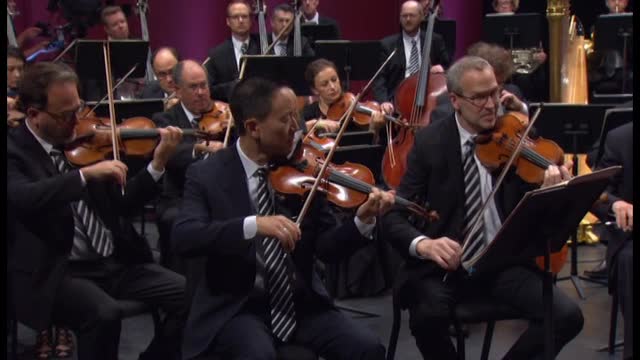
Both Goossens’s father and grandfather were conductors, his mother was a singer and his brother Leon and his two sisters were all outstanding musicians. When he was ten Eugene entered the Bruges Conservatory; from 1904 to 1906 he was a student at the Liverpool College of Music; and from 1907 to 1912 he studied at the Royal College of Music, where he was a pupil of Stanford. Here he conducted the college orchestra in his first major composition, Chinese Variations, which Sir Henry Wood subsequently invited him to conduct at a Promenade Concert in 1913. Between 1912 and 1915 Goossens was active as a violinist, being a member of the Philharmonic String Quartet and of the Queen’s Hall Orchestra. In 1915 he was taken on as an assistant by Sir Tomas Beecham, after which he devoted himself fully to conducting and also to composition. His conducting of his teacher Stanford’s opera The Critic was well received in 1916, and he went on to conduct provincial orchestras as well as the Leeds Orchestral Concerts. He founded his own orchestra in 1921, and at its first concert conducted the first British concert performance of The Rite of Spring in the presence of its composer Stravinsky. As a result he was invited to conduct Diaghilev’s Ballets Russes, the British National and Carl Rosa Opera Companies and many English and continental orchestras.
In 1923 Goossens accepted the invitation of George Eastman (the founder of the Kodak photographic company) to come to the United States as the first chief conductor of the Eastman-Rochester Orchestra in New York State, and he remained with the orchestra for eight years. He then succeeded Fritz Reiner as the conductor of the Cincinnati Symphony Orchestra in 1931, holding this position until 1946 and becoming an American citizen in 1943. As a patriotic gesture during wartime, in 1942 Goossens commissioned a set of ten fanfares from American composers, the most famous of which was Aaron Copland’s Fanfare for the Common Man. Following a visit to Australia in 1946 as a guest conductor for the Australian Broadcasting Corporation, he was invited to become chief conductor of the Sydney Symphony Orchestra and Director of the New South Wales Conservatorium of Music.
During the period of this dual appointment (intended to last for only three years, but which in fact extended to 1956) Goossens worked hard to improve standards both in the orchestra and at the Conservatorium, encouraging the performance of contemporary music and introducing Sydney audiences to works such as John Antill’s Corroboree, inspired by Aboriginal music. He also promoted Australian music both in Australia and overseas, and conducted the work of young composers such as Felix Werder and Malcolm Williamson. At the Conservatorium he staged operas such as Pelléas et Mélisande, Boris Godunov and his own Judith, the performance of which was the occasion of Joan Sutherland’s debut; he was also a leader in the campaign for the construction of the Sydney Opera House, and chose the site at Bennelong Point where it now stands.
Having previously been made a Chevalier of the Légion d’honneur, Goossens was knighted in 1955. As well as being a fine conductor, he was an accomplished composer, leaving two symphonies as well as a number of shorter works that well repay investigation. His two operas, Judith and Don Juan de Mañara, both had librettos by the distinguished writer and novelist Arnold Bennett. A customs scandal having summarily ended Goossens’s career in Australia in 1956, he returned to London to pursue the life of a freelance conductor. In addition he accepted several commissions, such as that from Sir Thomas Beecham to re-orchestrate Handel’s Messiah for full symphony orchestra, in preparation for Sir Thomas’s third recording of this work for RCA (1959). His health however gradually deteriorated and he died in Hillingdon Hospital, in Middlesex.
Goossens was a highly reserved man in public and his conducting was efficient and precise rather than involving; he was at his best in large-scale works such as those of the nineteenth- and twentieth-century Romantic composers. He recorded extensively from the acoustic era onwards. Among his earlier recordings of note are his accompaniments of the Liszt pupil Frederic Lamond in Beethoven’s Piano Concerto No. 5 ‘Emperor’, and of Fritz Kreisler in the Violin Concerto No. 1 by Max Bruch. During his period in America he recorded with the Cincinnati Symphony Orchestra the Violin Concerto and Viola Concerto of Sir William Walton, with Jascha Heifetz and William Primrose respectively, as well as notable accounts of the Symphonies No. 2 of both Tchaikovsky and Vaughan Williams.
The post-war discography of Goossens was equally distinctive, including accounts of his own Symphony No. 2, Scriabin’s Poem of Ecstasy, Balakirev’s Islamey, Bach’s Double Violin Concerto (with David and Igor Oistrakh), Fauré’s Fantaisie and d’Indy’s Symphonie sur un chant montagnard français (with Grant Johannesen), Khachaturian’s violin concerto with Igor Oistrakh, Britten’s Les Illuminations and Serenade (both with Peter Pears and the latter also with Dennis Brain), and Robert Still’s Symphony No. 3. Following his return from Australia he was engaged by the American record label Everest to make a number of recordings in stereophonic sound which perhaps present him at his best. The repertoire of this series was extensive: it included not only standard works by Rachmaninov, Rimsky-Korsakov and Stravinsky, but also lesser-known music by the American George Antheil, the Australian John Antill and the Argentinian Alberto Ginastera. With their sympathetic interpretations, fine performances and outstanding recorded sound, these recordings have been extensively reissued. They stand as eloquent testimony to Goossens’s gifts as a musician.
© Naxos Rights International Ltd. — David Patmore (A–Z of Conductors, Naxos 8.558087–90).
| Title | |
| ALL-STAR ORCHESTRA (THE): Program 15: British Enigmas / Program 16: Mysterious Mountain (G. Schwarz) | |

|
ALL-STAR ORCHESTRA (THE): Program 15: British Enigmas / Program 16: Mysterious Mountain (G. Schwarz)
Composers:
Bloch, Ernest -- Britten, Benjamin -- Copland, Aaron -- Creston, Paul -- Elgar, Edward -- Fuleihan, Anis -- Goossens, Eugene -- Hanson, Howard -- Harris, Roy -- Hovhaness, Alan -- Piston, Walter -- Rogers, Bernard -- Schumann, William -- Taylor, Deems
Artists:
All-Star Orchestra, The -- Schwarz, Gerard
Label/Producer: Naxos |
